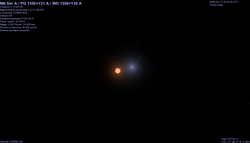NN Serpentis
[3] A planetary system has been inferred to exist around NN Ser by several teams.
All of these teams rely on the fact that Earth sits in the same plane as the NN Serpentis binary star system, so humans can see the larger red dwarf eclipse the white dwarf every 0.13 days.
Astronomers are then able to use these frequent eclipses to spot a pattern of small but significant irregularities in the orbit of stars, which could be attributed to the presence and gravitational influence of circumbinary planets.
[4] In late 2009 and 2010, researchers from the UK (University of Warwick and the University of Sheffield), Germany (Georg-August-Universitat in Göttingen, Eberhard-Karls-Universitat in Tübingen), Chile (Universidad de Valparaíso), and the United States (University of Texas at Austin) suggested that the eclipse timing variations are caused by two gas giant planets.
The more massive gas giant is about 6 times the mass of Jupiter and orbits the binary star every 15.5 years, the other orbits every 7.75 years and is about 1.6 times the mass of Jupiter.

